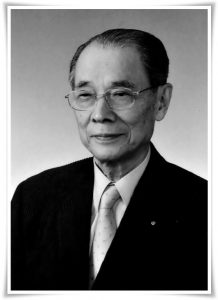
Through the efforts of Sakiko Yanagisawa (柳澤咲子), the Japanese PR magician of Beyond Calligraphy, an illustrated further exploration of the work and life of two Masters of the “Twenty Masters Exhibition of Modern Calligraphy (2012)” 現代書道二十人展, げんだいしょどうにじゅうにんてん, gendai shodō nijū nin ten) follows (link to Part I). The twenty participants of the exhibition are renowned calligraphers of modern Japan. Part II will discuss the work of Master Hibino Kouhou (日比野光鳳, ひびの こうほう, Hibino Kōhō, 1955 – present), Part III will focus on Master Furutani Souin (古谷蒼韻, ふるたに そういん, Furutani Sōin, 1924 – present).
Master Hibino Kouhou (Figure 1), born in 1928 in Kyōto, began his study of calligraphy with his father Hibino Gohou 日比野五鳳 (ひびの ごほう, Hibino Gohō, 1901 – 1985) at a young age. After graduating university, having majored in economics, he began a corporate career in a sake brewing company, Takarashuzou (宝酒造, たからしゅぞう, Takarashizō), from which he retired in 1965. Subsequently, he decided to devote his life to calligraphy.
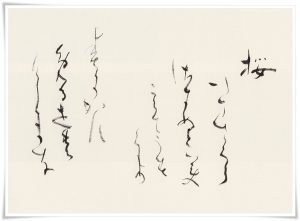
After two decades, Master Hibino Kouhou has been conferred the designation 文化功労者 (ぶんかこうろうしゃ, bunka kōrōsha, i.e. “a person who has made outstanding cultural contributions”). For 20 years, he has been a member of The Japan Art Academy (日本藝術院, にっぽんげいじゅついん, Nippon geijutsu-in), an organization which directly advises the Ministry of Education on art related issues and is the highest ranking artistic organization in Japan. He was also a lecturer in the cultural department of The Shrine to a Kindred Soul University of Kyoto (同志社大学、どうししゃだいがく, dōshisha daigaku ), his alma mater, and currently is a is a guest professor at Hanazono University (花園大学, はなぞの だいがく). In the years 1977, 1978, and 1987, he was awarded a special prize by The Japan Fine Arts Exhibition (日本美術展覧会, にほんびじゅつてんらんかい, Nihon bijutsu tenrankai) sponsored by the Ministry of Education. In the year 2000 he won a prestigious prize awarded by The Japan Art Academy. Master Hibino Kouhou is the President of The Suiho Calligraphy Association (水穂会, みずほかい, Mizuho kai), and the Director of The Japanese Kana Calligraphy Association (日本かな書道会, にほんかなしょどうかい, Nihon kana shodō kai).

The four works of Master Hibino Kouhou displayed during the “Twenty Masters Exhibition of Modern Calligraphy (2012)”, all were written in Japanese kana script. Originally, kana was developed as a script for women since culturally and historically at a given period they were, officially, not allowed to study Chinese characters. However, at various times in history, some male Japanese poets utilized kana as it assisted in and was appropriate for expressing emotions and delicate nuances through the medium of fragile, feminine, and sophisticated lines.
The poem in Figure 3 is titled “Ousaka Barrier” (逢坂の關, おうさかのせき, Ōsaka no seki), written 1000 C.E., during the Heian period, by Sei Shōnagon (清少納言, せいしょうなごん, 966 -1017 C.E.), Lady-in-waiting to the Empress consort Fujiwara no Teishi (藤原 定子, ふじわら の ていし, 977–1001 C.E.). It reads:
”夜をこめて 鳥の空音は はかるとも よにおうさかの せきはゆるさじ (よをこめて とりのそらねは はかるとも よにおうさかの せきはゆるさじ, yo wo komete tori no sorane ha hakaru tomo yo ni Ōsaka no seki ha yurusaji).
An interpretive translation follows:
“The watchmen of Hangu Pass (函谷關, pinyin: Hángǔ Guān, i.e. a gate located in a strategic position that was built in 361 B.C. by the state of Qin {秦國, pinyin: Qín Guó, 778 B.C.–207 B.C.}; many historical battles were fought there) were tricked by a disciple of Lord Mengchang (孟嘗君, pinyin: Mèngcháng Jūn), who mimicked the crow of a rooster, and the barriers protecting the gates were opened. However, the defenses of the barrier were too strong, and the guards could not be so easily fooled.”
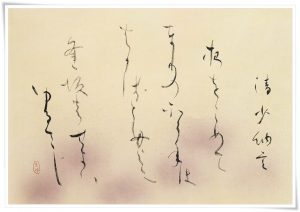
This tanka (短歌, たんか, i.e. “short Japanese poem consisting of 31 morae”) has yet another, deeper meaning as related by Japanese/Chinese editor Yuki Mori. Lady Sei shōnagon’s lover, the famous Japanese poet Fujiwara no Yukinari (藤原 行成, ふじわら の ゆきなり, 972 – 1027) , came to visit her one night but left earlier than expected under the pretext that he had to attend to some urgent Imperial Palace business. When she discovered that he had lied, she was very cross. The next time he came to visit her, she wrote this very poem in his presence. The words “よにおうさかのせきはゆるさじ” were directed at him and read “you are not allowed to go through the barrier”, one she conceived for him who had deceived her and meaning “you (implying Fujiwara no Yukinari) are not allowed to come to see me”.
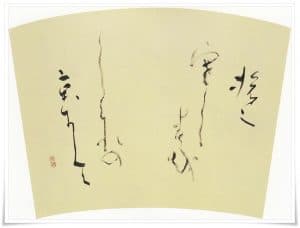
The poem references a mountain castle built on the border of Yamashiro Province (山城国, やましろのくに, Yamashiro no Kuni), which from 794 C.E. was the seat of the Imperial court (Yamashiro Province was located to the south of today’s Kyōto prefecture) and Oumi Province (近江国, おうみのくに, Ōmi no Kuni). Oumi Province is currently Shiga prefecture. The fortifications were restored and reinforced during the Heian period after being temporarily abandoned during the Enryaku period (延曆, えんりゃく, 782 – 806 C.E.).
The work itself is mesmerizing, a brilliant ink application. The dry strokes, so called “kasure” (掠れ, かすれ) in Japanese, ought to add dynamism yet sometimes weaken the connectivity of lines. However, in this calligraphy, they burst with power and energy like the rays of the sun through a thin mist of clouds. They appear to be powder-like ghostly silhouettes, yet are full of vigour and spirit. As a finale, at the end of the poem, a few characters are executed in bold and wet brush strokes to emphasise the strength and solidity of the defenses of the Ōsaka Barrier.
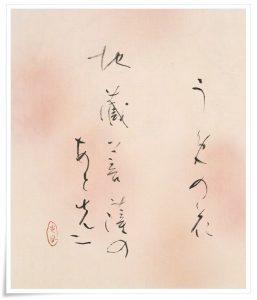
A comparison of all four works illustrates the commonality of a clearly distinctive writing style (書風, しょふう, shofū), representing a calligrapher whose knowledge and experience is unique enough to be able to create his or her own style of line. A further distinction follows. Each work has a, unique ambience. Close observation illustrates that they all differ from one another in a subtle way, elevating a true Master of calligraphy above those who still have a long journey ahead of them.
Text: Ponte Ryūrui (品天龍涙)
English editing: Rona Conti
Japanese/Chinese editing: Yuki Mori (森由季)
